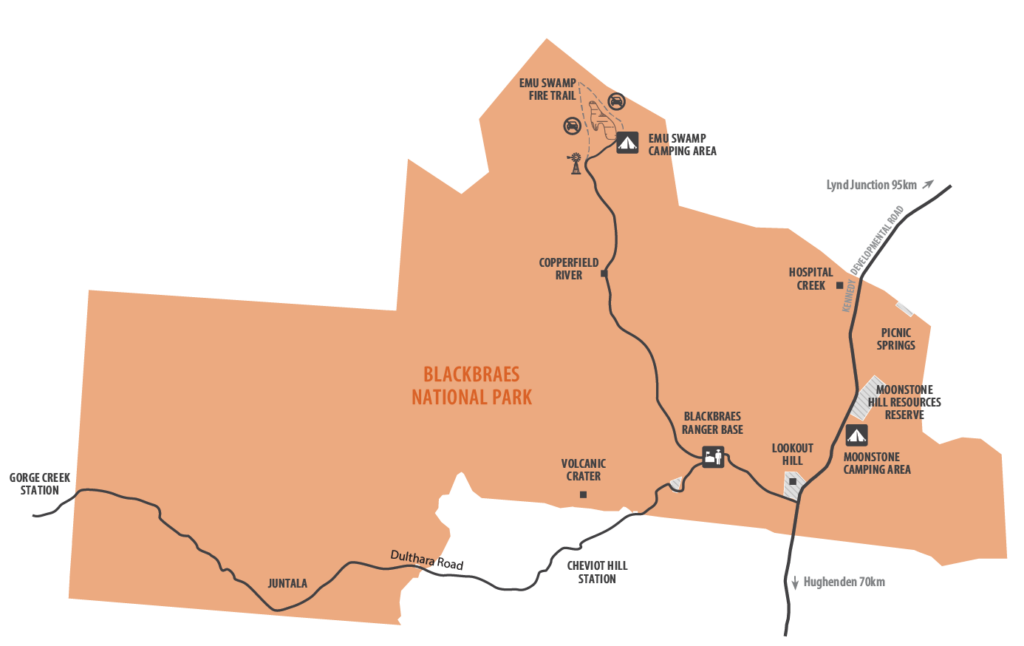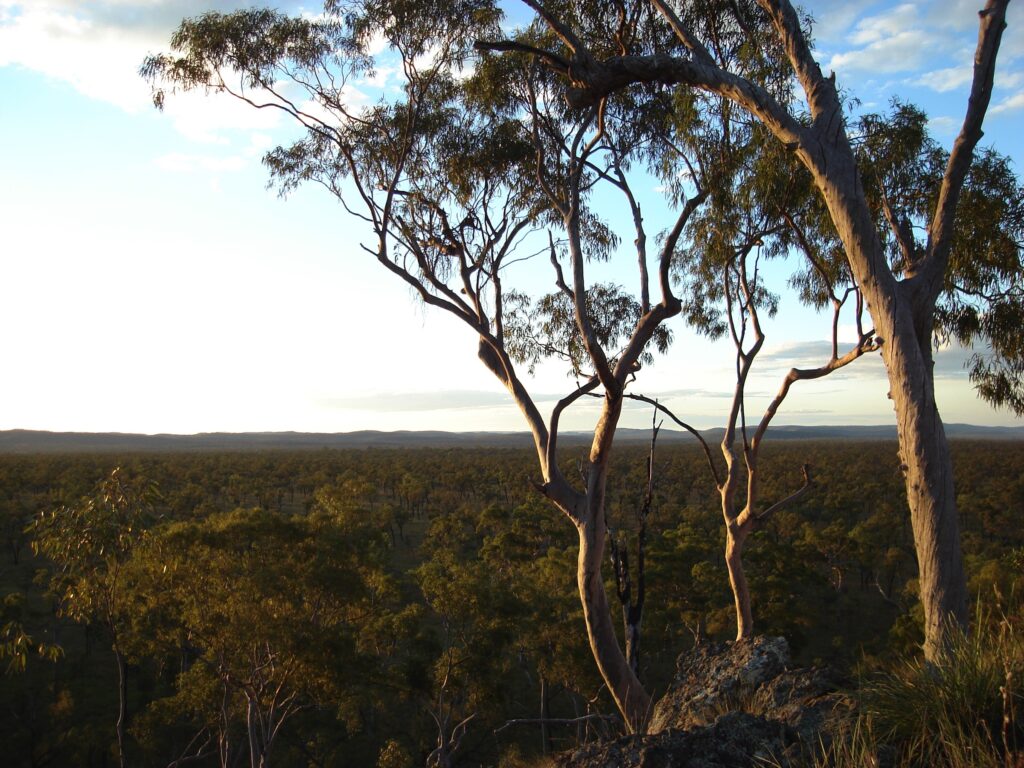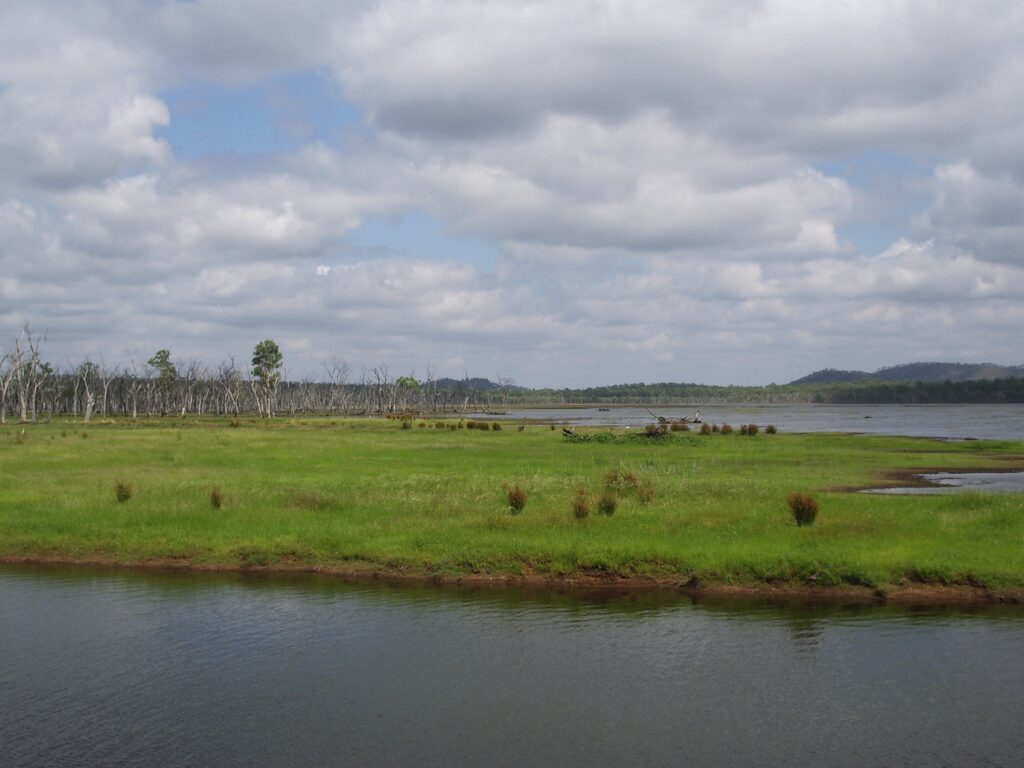
Blackbraes National Park and Resource Reserve, along with two other adjacent resource reserves Moonstone Hill and Kennedy Road Gravel, covers about 52000 ha. These parks and reserves also cover two bioregions, the Einasleigh Uplands and Gulf Plains. Rising and falling hills and ranges surround the basalt outcrops, black soil plains and seasonal swamps. The park is approx 850m above sea level so a wetter and generally cooler climate occurs in the area.

GETTING THERE
Blackbraes National Park is accessed via two possible routes. From Townsville follow the Flinders Highway 380km west to Hughenden. At Hughenden, turn on to the Kennedy Developmental Road and travel north for 170km.
Alternatively Access to the Lynd Junction is from Townsville (via Herveys Range), Charters Towers or Mount Garnet. From Townsville, follow Herveys Range Developmental Road for 109km through Herveys Range. Turn right onto the Gregory Developmental Road and travel 163km to the Lynd Junction. From Charters Towers, follow the Gregory Developmental Road north-west for 262km to the Lynd Junction. From Mount Garnet, travel 162km south on the Kennedy Highway to the Lynd Junction. The park is a further 95km south on the Kennedy Highway.
To access the camping area, follow the park road for 4.5km past the ranger base and turn right at the fork. Travel a further 14km and turn right at the windmill. The camping area is another 2km along this road.
The Kennedy Developmental Road is partially unsealed and may be temporarily closed or inaccessible after heavy rain. When dry, this road can be used by conventional vehicles with care. However, travelers should expect to encounter bulldust, corrugations, exposed rocks, creek crossings, other vehicles, native wildlife, cattle and road trains. Access to the park is recommended for four-wheel-drive vehicles only.

PARK FEATURES
Adjacent to Blackbraes National Park are three resources reserves: Blackbraes, Moonstone Hill and Kennedy Road Gravel resources reserves. The park and the three reserves together cover about 52,000ha, and straddle two bioregions: the Einasleigh Uplands and the Gulf Plains. Undulating hills and ranges surround basalt outcrops, black soil plains and seasonal swamps. The elevation of the park is 900m, providing a wetter and generally cooler climate compared with the surrounding country.
In basalt country, ironbark woodlands with native grasses dominate the landscape, providing food and shelter for many native animals. Grey kangaroos are common and birdlife is abundant.
Moonstone Hill Regional Park, a volcanic crater, is popular for fossicking gem-quality feldspar called “moonstone”. Moonstone emits a silvery-white to blue colour when turned in certain directions. Fossicking in the reserve requires a licence from the Queensland Department of Mines and Energy. For details and fossicking licenses contact the Flinders Discovery Centre or Department of Mines and Energy.
Bush camping
Camping at Blackbraes National Park
Bush camping is permitted near Emu Swamp Dam. There are no facilities. You can relax under the shady trees at an undeveloped bush camp at Emu Swamp Dam, and discover the birdlife that lives near the permanent waterhole and surrounding wetlands.
Camping permits are required and fees apply. A tag with your booking number must be displayed at your campsite.
Visitors wishing to camp need to be self-sufficient and bring water, rubbish bags and gas stoves. Fires are not permitted within the national park.
Camp Site Bookings
http://www.nprsr.qld.gov.au (and follow the links), by phoning 13 QGOV (13 74 68) or The Flinders Discovery Centre is an agent for National Park bookings. During holiday periods, you will need to book several weeks in advance. Please note there is no self registration available at Blackbraes National Park.
Campground features
A shady bush camp near Emu Swamp Dam, which is rich in birdlife.
Number of sites: Open area without separately defined sites.
Campsites are suitable for: tent camping beside your car, camper trailers and large groups.
Campsite surface: Dirt.
Facilities: None.
Open fires: Prohibited. Bring a fuel or gas stove.
Generators: Not permitted.
Essentials to bring: Drinking water, rubbish bags, fuel or gas stove, trowel or shovel, suitable
clothing for the winter months.
Mobile phone coverage: Not available.
Location
From the park entrance follow the road for 4.5km past the homestead and turn right (north-west) at the fork in the road. Travel a further 14km along the road to the windmill and turn right. The camping area is another 2km.
The park is particularly diverse in birds, with over 150 species of birds recorded.
Things to do
Fire trails
Grade: Easy to Moderate
Distance: various
Time: various depending on route taken
There are no formal walking tracks but visitors can walk along the roads and fire trails throughout the park and reserve. Expect to share the roads with trail bikes, vehicles and cyclists. Walkers must not enter private land, adjacent to the park and reserve.
Mountain biking
Mountain bike through Blackbraes National Park and Blackbraes Regional Park on the internal roads and fire breaks. Riders must not enter private land adjacent to the park and reserves. Expect to share the roads with pedestrians, trail bikes, vehicles and other cyclists.
Access to the park may be closed during the wet season. See park alerts for up-to-date information.
Trail bike riding and four-wheel driving
Ride trail bikes and drive four-wheel-drives through Blackbraes National Park and Blackbraes Regional Park on the internal roads and fire breaks. Vehicles and bikes must not enter private property adjacent to the park and reserves. Riders and drivers must be licensed and trail bikes and vehicles must be fully registered. Expect to share the roads with pedestrians, cyclists and other vehicles.
Stay on formed roads—trail bikes and vehicles are not permitted off-road.
Viewing wildlife
Birdwatching at Emu Swamp dam is popular with over 30 waterbirds recorded from the park and reserves. At night, spotlight for greater gliders, rufous bettongs, bandicoots, insects, frogs and snakes.
Gem fossicking
Fossicking at Moonstone Hill Resource Reserve (located approx. 5km north of the Blackbraes National Park turn-off) is popular with gem collectors and lapidary enthusiasts. Fossicking in the reserve requires a licence.
Things to know before you go
Opening hours
Blackbraes National Park and Blackbraes Resources Reserve are open 24 hours a day. The camping area is open during the dry season—usually from March to November, but may be closed at other times, dependent on weather conditions. See park alerts for up-to-date information. Contact the Department of Transport and Main Roads to find out about local road conditions and the Bureau of Meteorology for weather reports and forecasts.
Permits and fees
Camping permits are required and fees apply. A camping tag with your booking number must be displayed at your camp site.
Fossicking in Moonstone Hill Resources Reserve requires a licence from the Department of Employment, Economic Development and Innovation.
Permits are required for commercial or organised group activities. Contact us for further information.
Pets
Domestic animals are not permitted in Blackbraes National Park.
Climate and weather
In summer, daytime temperatures can exceed 35 degrees Celsius. The cooler months of the year, from May to August, are the best times to visit. However, night time temperatures can drop below six degrees Celsius and frosts can occur during the winter months. Visitors should bring warm clothing. Most rain falls in the summer months, December to March. There is little rainfall in winter. Weather forecasts are available from the Bureau of Meteorology.
Staying safe
This area is very isolated so it is important to plan your trip carefully and be prepared for any emergencies.
Carry at least one form of communication equipment. Satellite phones and Personal Locator Beacons (PLBs) are the most effective in this area. Mobile phone coverage is unreliable.
Ensure you carry plenty of drinking water.
Carry adequate food, first-aid equipment, fuel and basic vehicle repair equipment in case of unexpected delays or breakdown.
Flinders Discovery Centre
37 Gray Street, Hughenden Q 4821
PO Box 274, Hughenden Q 4821
Ph: (07) 4741 2970
Email: info@flinders.qld.gov.au
QPWS
Disraeli Street, Hughenden Q 4821
Ph: (07) 4741 1113




